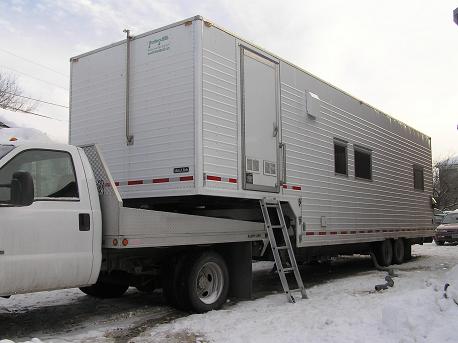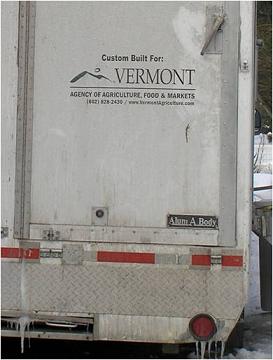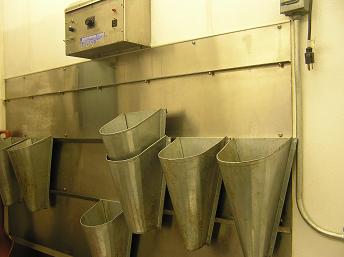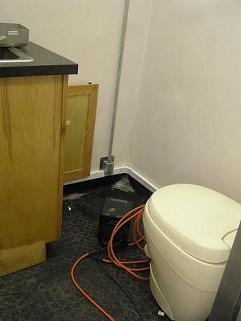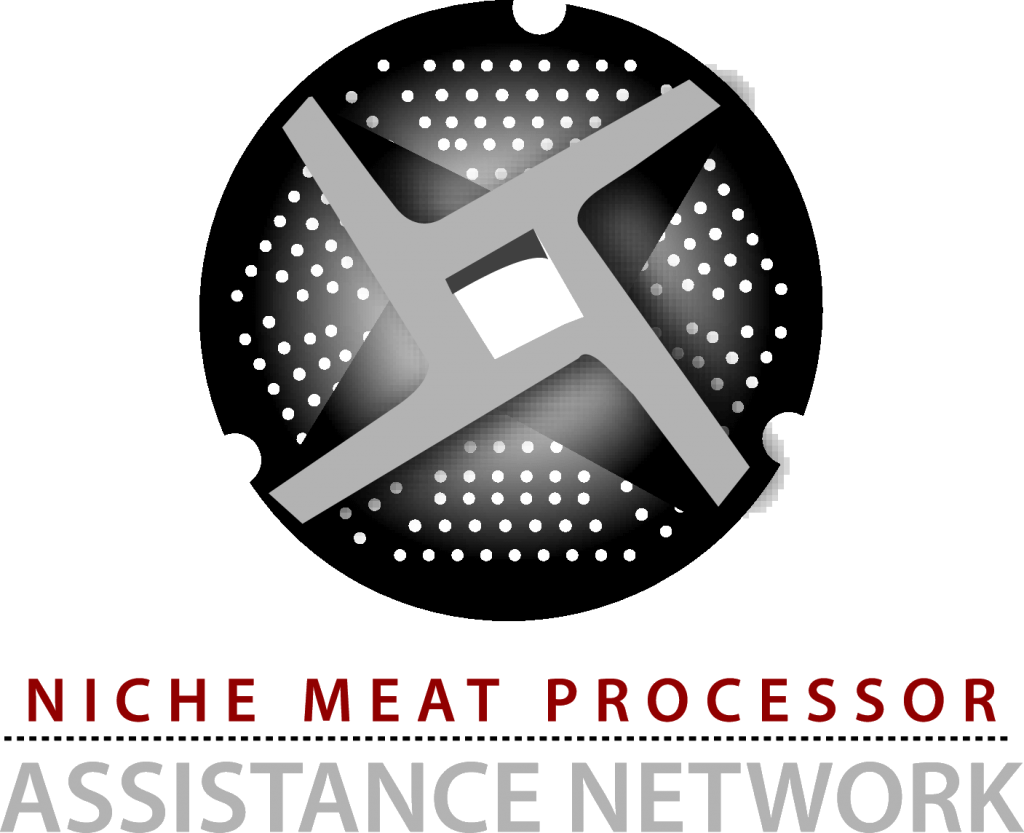Updated March 2018
In January 2012, this unit transitioned to new ownership. After the original operator decided not to renew his lease, the state of Vermont put the unit up for auction. It was purchased by Tangletown Farm, in Middlesex, VT. The new owners developed an operational plan with the help of the Vermont Farm Viability Enhancement Program. As of 2018, they are utilizing the unit, but only to process their own birds. They process under Vermont Meat & Poultry inspection, which allows them to sell anywhere in the state of Vermont, as well as do cut-up and further processing such as chicken sausage. Currently, they are unable to let other farmers use the unit due to liability risk.
To see the blueprints for this unit, click here.
The information below is about the unit when it was owned by the State of Vermont and operated as Spring Hill Poultry Processing prior to 2012.
Basic information
Capacity per day: 250 chickens (more with additional vehicle & chilling tanks) or 100 turkeys (depending upon size), with two people.
Hours/day of operation: 8 AM – 5 PM. Depending on distance to site, he may have to leave as early as 4 AM and could return at 8 or 9 PM.
Days/week: As needed
Weeks/year: As needed
Species: Chickens and turkeys; possibly ducks and geese if there is demand
Services: Slaughter, processing, further processing (e.g. pieces, boneless breasts), and packaging
Square feet: 288 sq. ft. (36 x 8 feet outside dimensions); pulled by pick-up truck (F-550 or larger)
#/type of employees: In start up phase (4 months in 2009), operator worked alone or w/casual help. Plans to have part-time employee in 2010
Annual revenues: No data as yet; first season was partial
Price of services: $2.75/chicken; $4.75/turkey or $6.75 if over 25 lbs. Extras: $0.50 to bag, $0.75 to vacuum pack (per bird/all species). Same rates for state inspected and exempt (under the per farmer max of 1,000 chickens/250 turkeys). (Fees will be updated per 1st season operating costs.)
Operational costs: Operational costs include propane, diesel fuel (for truck), labor, and ordinary maintenance:
- Four 40-pound LP tanks have lasted for >1 day of 1 person processing 100 birds.
- Insurance (trailer, truck, and product liability) = $3,500 a year.
- Mileage charge was $0.95/mile (one way charge) but will be $1.05 in 2010.
Fixed costs include lease ($9300/yr), truck loan payments, and depreciation. George has negotiated an agreement with the state to deduct (from lease payments) required repairs and retooling due to poor design and construction.
The lease payment is 1/10th the cost to the state to build the unit, ~$93,000; the state will recover this cost in 10 years through the lease payments.
Retail on-site: No, but a producer can conduct retail sales on site with a state permit, and he/she can get temporary approval from an inspector while awaiting the permit.
Wholesale: No
Inspection: State-inspected. Can be used for itinerant slaughtering (1000 chickens/250 turkeys/yr per producer). Can process birds from out of state, but not under state inspection.
Certified organic: No (very little demand for it)
Certification agency: n/a
Custom work: Yes
Source verification on label: Spring Hill Poultry Processing provides its own label with inspection. Producers who have their birds processed under exemption don’t receive a label from Spring Hill and must provide their own label with a statement of exemption on it. Producers that want to have their own label must go through the normal label approval process with the state, just like other wholesale and retail operations.
The market opportunity
In Vermont, as in much of the U.S., a once vibrant processing industry has shrunk dramatically, while the demand for local food, hence local processing, has been steadily rising. An increasing number of Vermont’s small-scale poultry growers were looking to expand their operations beyond the 1000-bird limit for exempt slaughter (VT does not recognize the 20,000 bird federal exemption). They weren’t ready to invest in their own on-farm processing facilities, and other options were disappearing. The three existing inspected processors that did custom (fee-for-service) work – two of which are farms that established USDA-inspected poultry processing facilities primarily for their own use – were maxed out or had discontinued this service in order to process their own product without interruption.
(A USDA-inspected red meat and poultry slaughter/processing plant was scheduled to open in southeastern Vermont in October 2009, but had not as of December ‘09.)
The people/organizations involved
George Eisenhardt is the operator and lease-holder; his business is called Spring Hill Poultry Processing. His father operated a red meat slaughterhouse; George grew up in the business and worked there all his life, until 1998 when they shut down because of the cost and difficulty of meeting new leach field requirements. The family added poultry during their last few years of operation, and that area of the business was actually growing when they closed.
Ed Jackson, as the (former) Agricultural Development Coordinator with the Vermont Agency of Agriculture, focused on the livestock and meat processing industry. As the operator of a diversified livestock farm, marketing his products both wholesale and retail, and as an active board member of various producer organizations, Ed has first-hand experience with many of the challenges facing meat producers and the processing industry in Vermont and the Northeastern U.S.
History and development
The Vermont Agency of Agriculture undertook this initiative as a response to poultry producers being shut out of the market due to their lack of access to an inspected slaughter facility. Ed Jackson provided key leadership in creating the sustainable infrastructure needed to bring local meat and poultry to the table. At first the state tried to find some way or someone to build a conventional, stationary slaughter and processing plant, but that wasn’t an attractive business proposition, as the relatively small number of birds distributed across the state didn’t justify the investment.
In 2006, Ed and others at the Vermont Ag Agency started planning a mobile processing unit to serve these producers. “We wanted to grow the Vermont brand of poultry – we needed an inspected facility,” he said. The state legislature supported the project and appropriated $85,000 of funding in 2008. The unit, considered a prototype, was built and delivered in October 2008.
The state contracted with Brothers Body and Equipment in Ohio to create the blueprints and construct the unit. It selected this contractor based on the firm’s bid and its reputation in constructing both food service trailers, and several service trailers for other government agencies.
Construction was largely “overseen” from afar, via phone conversations and email exchanges, including photos. On two occasions Vermont’s Chief of Meat Inspection visited the plant in Ohio to inspect progress.
The state’s plan for the unit was to find a competent, interested operator to lease-to-buy or outright purchase the unit. It took almost a year to find someone to operate it. George Eisenhardt began considering the opportunity in June 2009 when IBM, his employer of over a decade, changed his position and alternatives didn’t work out.
The lease-to-purchase agreement consists of two-year renewable leases with up to four renewals and a buy-out option. The leaseholder will automatically own the unit after ten years of lease payments. The operator of the unit provides a service for which he receives a fee.
One of the challenges to operating the unit profitably has been the absence of cost data for this type of business model. Collecting actual cost data in this first year of operation has been essential and should help to define rates and fees going forward.
The state has incurred $7000 of additional expenses due to design changes and operational issues of the prototype. Once these are taken care of, the state does not anticipate any additional expenses.
The state has designated one inspector for the MPU, but there are other inspectors who can fill in when necessary. George tries to schedule 2 weeks in advance, but the state has been able to provide an inspector on less notice.
Funding sources
The Vermont state legislature appropriated $85,000 to fund the unit, which ended up costing about $93,000 to build. The extra $7000 was granted by the Castanea Foundation, a Vermont-based private funder.
The lease agreement was conceived as a method to recapture the initial investment, so that if this model were successful, another unit could be purchased and placed in service. This plan relies on there being enough political will to spend the lease receipts in this way, which is certainly not guaranteed.
Business plan – How it works
The state did not have a formal business plan for the unit.
As the state owns the MPPU, George’s only financial risk was purchasing the F-550 truck, which at about 7400 lb. is the minimum size vehicle required for transporting the 18,000 lb. trailer, and some additional equipment. He started writing a business plan to qualify for a loan for the truck, but his local community bank approved his loan before he had completed his plan. This bank has a history of agricultural lending, and officers understood the need and potential for an MPPU.
In developing his business plan, George says he underestimated the demand for the MPPU and its potential to grow. He is currently putting together a state grant application to add a refrigerator vehicle to his business for use when he is servicing larger producers. The vehicle will contain chilling tanks for more rapid cooling and will also provide additional space for boning. He will have to hire an employee to drive this vehicle and help with the additional business volume.
His business plan also underestimated his expenses. This winter (2009-2010), he will calculate first-season costs and plan how to reduce them.
Volume is where you make your money, says George, so he is eager to work with larger producers. His per-producer bird minimum is 100 chickens, or 50 turkeys. He will only process smaller numbers if a producer can arrange to bring the birds to a farm site where George is processing other birds.
Deciphering regulations and complying
As a veteran slaughterhouse operator, George is familiar with the regulations and has had no problems with compliance. Per requirements, he has a HACCP plan.
Plant design and equipment
As noted above, the state contracted with Brothers Body & Equipment to build the trailer. The final design was the culmination of input from different parties, although apparently no one with experience in the slaughter business (except for inspectors) was involved at this stage. State meat inspection staff, with some technical support from Ag Agency’s engineers, developed a rough drawing. Agency discussions with the contractor on cost control were factored into this preliminary plan. No actual blueprints were ever created.
Like others in the slaughterhouse sector, George was skeptical at first of the state’s intention to create a mobile processing unit. “I was one of those who thought they were crazy,” he said. However, he now wishes he had been involved with the design.
For example, the trailer has an aluminum-clad steel frame. For the required washable surface, interior walls are pebble board, which was a poor choice as it is not easy to fully clean.
Poultry are slaughtered in kill cones hung on a stainless steel wall in the killing and bleeding room. A stun gun assembly is installed above the kill cones.
An Ashley scalder and a Pickwick-Knase plucker are installed on the other side of the room. This whole area is divided from the evisceration area by a wall as required by USDA regulations.
Scalder, plucker, hand sink, and wall separating kill area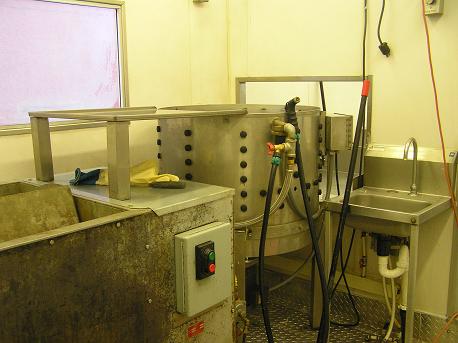
Birds exit the plucker through a door that opens automatically on a timer. Next they are shackled (five chickens per shackle) and hung for evisceration over a two-person stainless steel table. The inspector stands at the table, checking birds as they are done. The birds are iced in plastic chilling tanks for cooling and then drained.
Chilling barrels: middle one is for hearts, livers, necks; vaccum packer is in upper right corner
Finally the birds are bagged or vacuum packed and weighed and labeled. The trailer came equipped with a bagger, which did not work, so George purchased a vacuum packing machine.
Window where birds exit from plucker; on left rear is vacuum packer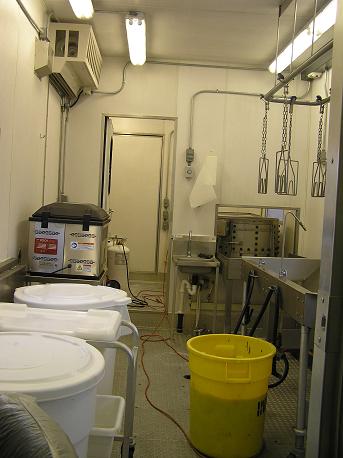
The rear door has a rollout ramp that is helpful when transporting birds into the unit, or moving chilling tanks.
George purchases ice from Vermont’s only large supplier of ice made from potable water. This vendor has outlets conveniently located around the state.
The MPPU has an 18,000-kilowatt liquid propane (LP) generator with four 40lb LP cylinders installed in a generator room in the front of the trailer over the hitch. Metal stairs allow access from the driver’s side, where the cylinders are stored.
Generator room above trailer hitch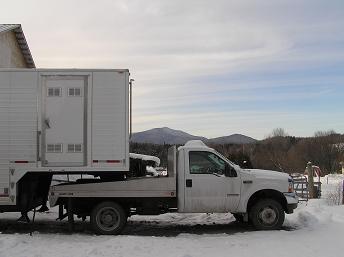
The trailer has a shoreline, so the generator isn’t required if 50 amp service is available and there is a place to plug in a three-prong welder hook-up. Usually though, there is no outlet close enough to the parking site. (George noted that the plucker works better – has more capacity – when powered by the generator than when using grid power, which he attributed to a drop in power transmitted through the shoreline.)
The trailer has hand sinks in the kill room and evisceration area but lacks a double sink. A small electric on-demand water heater came with the unit, but it didn’t function in the wet environment and is being replaced with a propane on-demand water heater.
On the front end of the trailer are two tiny rooms: a restroom equipped with an RV-type dump tank and the inspector’s office.
Big Glitches and how they were solved
Both the plant operator and the Vermont Agency of Agriculture have learned a great deal from this experience. The plant, as originally constructed, has major flaws, many of which George feels could have been avoided if he had been involved in designing it. Some of the choices made in its design are counter-intuitive, such as the choice to include the restroom and inspector’s office, both of which George considers a waste of limited space, and the lack of a double sink. Similarly the trailer has a nine-foot ceiling, at least one-foot higher than necessary, adding considerable unnecessary weight to the structure.
Other problematic features may be the result of cost-cutting measures, such as the difficult-to-wash walls, or a lack of familiarity with day-to-day activities in a processing plant, such as permanently installing equipment right against the wall. George explained that all equipment should have adequate space around it, the scalder and plucker should be on wheels, and tight corners avoided, all to assure ease of cleaning and repair. (Equipping the plucker with a feather catcher would also aid in cleaning.)
The trailer is minimally insulated at best and therefore is not suited for winter use. It has no heating system, although George notes that the scalder heats up the small trailer, so additional heat may not be necessary. However, the metal floor, under which there is only half-inch marine plywood, stays extremely cold in winter weather; at times, ice has formed inside unused equipment.
The power generator is larger than necessary, and so the unit uses more fuel than necessary. A heat shield under the scalding tank would increase the efficiency of fuel, and would have also prevented the floor from warping.
The unit was delivered and the state signed off on it without putting it to an operational test. Equipment warranties had already expired before George leased it and got it on the road. Thus the non-functional bagging unit sits in the trailer, unused.
Following the unit’s first partial season of operation, in late 2009, George will rectify several problems during the winter. He has negotiated an agreement with the state under which he is able to deduct the cost of planned repairs from his lease payments. To cover the repair costs before he can deduct them, he is borrowing money from his bank. It would have been much more difficult to get the state to undertake these repairs directly for several reasons: the state would have to solicit multiple bids for each repair; the state does not have an appropriation to cover the repairs; and the state does not have staff with the time and know-how to figure out what needs to be done and provide oversight of the work.
The planned repairs/alterations are as follows:
- The floor slopes away from the floor drain, rather than being tapered toward it as USDA requires (and common sense demands), so standing water accumulates during processing. The estimated cost of redoing the floor to correct this problem is $3600.
- The scalding unit, heated with propane, lacks a power vent. In the close quarters of the trailer, which has two vents, using the scalder creates negative pressure so fumes build up.
- The propane-fired generator fails to start or malfunctions in cold weather because of inadequate propane delivery. When the scalder is running, it diminishes the fuel available to the generator and causes it to run rough, affecting electrical output. This is also a design issue: in the original design, propane must go through three elbows in the four feet between the generator and the supply line (each elbow is equivalent to a 10 foot run in terms of delivery capacity). George is working with the gas technician on a two possible solutions: increasing the size of the delivery pipe to the generator or adding a heating system to the room with the LP cylinders.
- An electrical contractor will install an alternative to ground fault protection in this wet environment so that electrical outlets will function consistently.
Staff needed, how they were found and trained, and what they cost
George is currently a solo operator, though he expects to hire one employee in 2010. He is not yet making a living off the MPPU but believes that will happen in his first full year of operation, 2010.
Financial sustainability plan
George is confident that the unit will be financially self-sustaining. Starting in 2010, George anticipates making enough income from the unit for it to be financially sustainable for him as the operator and leaseholder, while paying himself a living wage and benefits. In addition to paying rent, he has a three-year loan for his truck, which he might be able to pay back sooner.
Keeping cash flowing and people busy during seasonal slow times
George is not counting on cash flow from the MPPU over the winter and most of the spring. In fact, he has taken a job for the winter (’09-’10), and the MPPU is parked for the winter at a poultry farm in Morrisville. Based on his experience, George predicts that the unit will be busy from June until November. (In Nov. ’09, he worked just about every day, including weekends, except Thanksgiving).
Markets accessed
The poultry producers served by this processing unit mostly sell direct to consumers, with some sales to restaurants.
Lessons learned
Several important lessons have already been learned in the initial operation of the unit:
- Always have an experienced processor involved with plant design and oversight of fabrication and installation of equipment.
- Set up a clear agreement with customers before bringing the MPU to their farms. The agreement must spell out requirements for vehicle access and an adequate supply of potable water. George has learned the hard way that all poultry producers who hire his services do not have an appropriate site for the MPU. Rugged driveways have damaged the trailer, which is “not a mountain goat!” In one case, he ran out of water.
- Adding another, optional vehicle is an inexpensive way to increase the capacity of a MPPU. George intends to purchase a reefer truck (it is currently a buyer’s market for trucks) for chilling more birds and value-added processing. He would only use the additional truck on days when he is killing large numbers of birds.
- George expects that this prototype MPPU will be subject to stress cracks and will not last as long as anticipated, given the weather extremes and condition of the roads being traveled. A more modest, basic, lighter-weight model made of more durable materials would be preferable.
- The lack of good data on the quantity of poultry being produced in Vermont was an impediment in assessing the viability of this type of enterprise.

